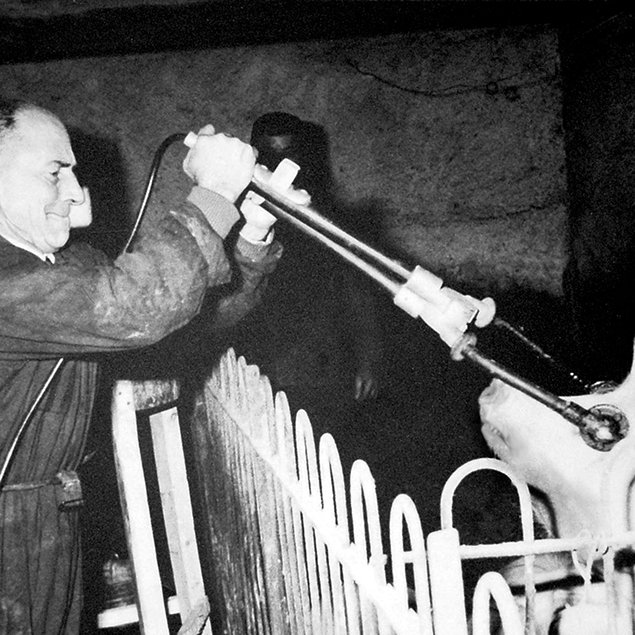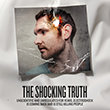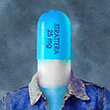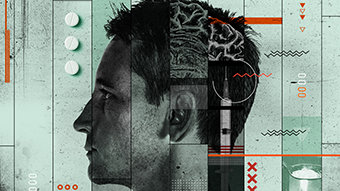Of all the problems that Kenneth Fleischman suffers from—glandular disorder, fatigue, nightmares—none compares with what he refers to as his “identity crisis.”
A 28-year-old native of Michigan, Fleischman doesn’t remember anything about high school, except that he graduated in 2007. He spent years relearning how to read, write, drive a car, even retie his shoelaces. In a world where everybody needs memories to retain some sense of self, Fleischman has almost none.
Fleischman is a survivor of “electrotherapeutics,” a term the dictionary defines as the treatment of disease by electricity. America has thousands of people like Fleischman—and they all have one thing in common: electricity has destroyed their brains, and therefore their lives.
For about a year until late 2010, psychiatrists applied electric shocks to an area of Fleischman’s scalp just above the frontal lobes of his brain—a procedure that psychiatrist Peter R. Breggin, one of ECT’s foremost critics, refers to as a “closed, head lobotomy.” The practice, repeated 30 times every few weeks on Fleischman, was aimed at curing what psychiatrists had diagnosed as depression caused by hypothyroidism, a condition marked by abnormally low activity of the thyroid gland.
Fleischman’s moods had steadily deteriorated since he was 14 years old. The reason, he reckons, wasn’t because of a disease but the fact that he had been put on a toxic cocktail of six different anti-depressant drugs.
“I was told there was one last treatment,” Fleischman recalls, referring to electroconvulsive therapy (ECT), a procedure in which patients are anesthetized and their heads zapped with an electric pulse of up to 450 volts, about 4,500 times higher voltage than the brain typically uses. The searing current, delivered by a machine, typically results in a seizure followed by a coma.
“Memory loss and side effects will be temporary, I was told,” says Fleischman, recalling the boilerplate explanation that psychiatrists tend to give to prospective patients, rarely disclosing that ECT can cause anything from intellectual impairment to death. “So I went through with it.”
PROMOTING ELECTROSHOCK
The Food and Drug Administration (FDA), which grandfathered the ECT machine into approved use in 1976 without any evidence of effectiveness or safety, acknowledges “significant risks” associated with the therapy. “Risks” is a mild term for a litany of horrors ranging from adverse skin reactions, dental trauma and cardiovascular complications to worsening of intellectual ability, prolonged seizures, profound memory loss and death.
Despite widespread criticism in scholarly circles and the media about the dangers of electroshock, ECT has been adopted by almost every major psychiatric institution in the world. Use of ECT spread rapidly through postwar United States and Europe after Ugo Cerletti, an Italian professor of neuropsychiatry who experimented with electroshock on pigs at a Rome slaughterhouse, published the results of his research in 1938.
By 1953, some 300 patients at any given time were receiving ECT in just one psychiatric hospital—Pilgrim State in New York. Until as late as the 1970s, psychiatrists unabashedly advocated for the use of ECT, likening depressed people to automobiles with weak batteries in need of a recharge. Opposition to ECT’s use began to grow as patients reported suffering from spinal, pelvic and jaw fractures caused by seizures, prompting courts to ask for better regulation of the therapy as well as more research on its safety and efficacy. News reports about the “Georgia Power cocktail”—a touch of gallows humor referring to the Georgia State Sanitarium, where uncooperative patients tended to be given electric shocks—helped the opposition’s cause.

Over the years, the most visible perils of electroshock were suppressed as doctors began anesthetizing patients before treatment, thereby minimizing the violence of the seizures that accompany the shock. The popular image of “Edison’s machine,” as ECT was once called, got a makeover, away from what one critic aptly described as the “snake pit” era of the “soul-crushing asylum.” But the brain damage caused by passing high voltage through the brain did not change.
Today, some 200,000 Americans undergo ECT treatments each year, resulting in an estimated $1.8 billion in revenue. The unapproved, so-called “off-label” use of ECT among children—that is, in a manner not specified by the FDA—is widespread.
The commercialization of psychiatric treatments is a major driver of ECT use: It is much cheaper for health insurance companies, especially HMOs, to pay for electroshock than a multiyear course of antidepressant drugs. That’s one of the arguments in Pushbutton Psychiatry: A History of Electroshock in America, an authoritative 2002 book by Nazareth College political scientist Timothy W. Kneeland and University of Kansas sociologist Carol A.B. Warren.
Psychiatrists, write the authors, benefit handsomely from ECT use because they must be present, and therefore paid, for every electroshock treatment. In a striking 1998 court case in Los Angeles, for example, a psychiatrist named Glen Peterson testified that he once gave a woman, who had undergone numerous ECTs, 130 to 140 shock treatments every few weeks. Peterson admitted that he used the highest possible voltage to treat his hapless patient and that he had no intention to stop giving her further shocks.
ECT—UNREGULATED, UNTESTED
The current controversy over ECT began in January 2011, when an FDA advisory panel opposed an FDA suggestion to lower the therapy’s so-called “risk classification.” (The FDA divides medical devices into three classes, based on their level of risk to patients: Class I devices are considered low-risk, Class II devices carry moderate risks, and Class III devices, including ECT, are high-risk.) After two days of public hearings, a majority of the FDA panel members voted to keep ECT equipment in the high-risk category instead of ranking it as a moderate-risk device. Further, most of the panel members expressed concern over the lack of studies documenting the safety and effectiveness of electroshock.

Proponents of ECT have never pointed to a single proven theory or definitive study to explain how or whether the process works, let alone whether it is safe and effective. One of ECT’s most tenacious salesmen, the neurologist Walter J. Freeman, claimed that the treatment worked because of the brain damage it causes—that is, the therapeutic effect results from the damage. “Maybe it will be shown that a mentally ill patient can think more clearly and more constructively with less brain in actual operation,” Freeman stated in a 1941 medical journal.
Perhaps the strongest evidence so far that electroshock damages the brain came in a 1978 survey of ECT practitioners by the American Psychiatric Association (APA). The study revealed that as much as 41 percent of the respondents agreed that electroshock caused brain damage.
Little wonder that opposition to ECT from people who have undergone the treatment has been particularly severe. When the FDA invited public comments regarding its proposal to change ECT’s risk classification, over 3,000 responses poured in. Nearly 80 percent opposed reclassifying ECT devices to the moderate-risk category. Some 1,882 of the comments reported “adverse events” that evidently occurred during treatment, including 529 instances of memory loss, 296 complaints of brain damage, 413 cognitive grievances, 43 reports of suicidality and 103 deaths. An additional 6,462 individuals from 92 groups further opposed the FDA’s reclassification efforts.
The FDA not only disregarded the public comments but also a number of adverse events reported by device makers and professionals, and recorded in the agency’s MAUDE (Manufacturer and User Facility Device Experience) database. Of the 448 reports on file, 117 pertained to memory loss, 35 to functional disability and 17 to burns from faulty wiring and other causes.
ELECTROSHOCK’S CARPETBAGGERS
ECT machines in the U.S. are sold by just two companies. One of them, MECTA (an acronym for Monitored Electro Convulsive Therapy), is based in Oregon and owned by a husband-and-wife team who have no background in electronics or medicine. The other company, Somatics LLC, is based in Florida and owned by two shrinks, Richard Abrams and Conrad Swartz, who are professors of psychiatry respectively at the Chicago Medical School and the University of South Carolina. (Swartz also manages and plays guitar in a rock band called “Insanitizers.”)
Although Somatics touts itself as “the world leader in ECT innovation and sales,” according to its website, the company has not manufactured any electroshock machines since its inception in 1984. Somatics procures its machines from Elektrika, a company in Islip Terrace, New York, and then labels and distributes the devices in 62 countries worldwide. Many of the importers are developing nations that perform so-called “unmodified” ECT—electroshocking patients without anesthesia, potentially resulting in broken bones and teeth—a practice that the United Nations Special Rapporteur on Torture has condemned as torture.
“I am emotionally hurt and angry to see people damaged by such a blunt and brutal instrument as electroshock, inflicted by the people they reach out to for help. This is a terrible violation of the Hippocratic Oath and a human tragedy.”
Dr. John Breeding
For a company with global reach, led by a pair of psychiatrists who clearly favor ECT as the first rather than last resort for treatment of mental conditions, Somatics is surprisingly inept at complying with FDA regulations. During an inspection of the company’s Florida headquarters this past April, an FDA investigator found at least 10 “objectionable conditions” related to everything from improper documentation of products and software upgrades to the lack of responses to customer complaints.
According to an “Establishment Inspection Report” obtained via a Freedom of Information Act request by the Citizens Commission on Human Rights—a nonprofit mental health watchdog founded by the Church of Scientology—Somatics failed this past March to conduct “risk analysis documentation” for the Thymatron IV, a Class III ECT device that the firm markets as far more efficacious than a similar machine sold by rival MECTA.
Referring to a lack of risk notification, the FDA investigator, Richard K. Vogel, wrote in his report about the Thymatron’s documentation, “It lacks risk of burns and risk of memory loss.” He added, “It lacks risks related to heart rate monitoring or EEG (seizure) monitoring.” The flawed documentation might not have been so egregious if Somatics hadn’t failed to report a complaint by a Thymatron customer that a patient’s head had been burned during an ECT session with the machine in 2013.
According to Vogel’s inspection report, a staff member “smelled a burning odor” and “found a blister on the patient’s head” in a spot where an electrode had been placed to transmit a searing current to the brain. Vogel wrote that he told Somatics General Manager David Mirkovich that he “should have documented this as a complaint” and submitted it to the FDA under the agency’s medical device reporting (MDR) rules.
“He said he thought it was already submitted by the user facility,” Vogel continued in his report, adding, “I agreed, but stated it was also required to be submitted by his company as the responsible specification developer.” (A prior FDA inspection of the Somatics headquarters in 2012 noted that the firm had no “standardized review process for determining the criteria for identifying an MDR reportable event.”)
A similarly callous approach to dealing with complaints was demonstrated by MECTA, which has been sued half a dozen times for harm to patients from its ECT machines. Asked by a lawyer for the plaintiffs during one of the device maker’s liability trials in 2005 whether severe loss of memory would be a “serious enough complaint to deal with,” the firm’s co-owner, Gorham Nicol, replied, “We don’t deal with it unless it’s from a doctor or hospital.” Nicol, who has a masters in business administration, was also asked at the same trial if his firm employs anyone capable of conducting ECT clinical studies. His reply, “Absolutely not.”
OVERHAULING AMERICAN HEALTH
It’s partly against the backdrop of such business practices that health activists deplore the FDA’s sustained efforts to reclassify ECT machines. In July 2015, manufacturers of medical devices as well as pharmaceutical drugs received a big boost when the House of Representatives, with bipartisan support, passed the “21st Century Cures Act,” one of the largest FDA “reform” bills to be approved by the House in recent years.
Critics fear that the proposed law will have profound consequences for public health because the legislation contains a provision for fast-tracking FDA’s approvals of “innovative” medical devices and drugs. The bill stalled in the Senate, but the primary sponsor, Fred Upton, a Republican from Michigan, has stated he plans to revive it in the lame duck session after the 2016 election. Not surprisingly, Upton was the top recipient of contributions from pharmaceutical companies in 2013-14, according to OpenSecrets.org, a nonprofit website that tracks federal campaign contributions and analyses lobbying data.
In December 2015, after failing to take any action for four years on reclassifying ECT as moderately risky, and despite advice from its own advisory panel that it not do so, the FDA issued a so-called “proposed order” to fast-track ECT as a Class II device. The order, still under consideration by the FDA, effectively puts ECT in the same, less restrictive category as motorized wheelchairs and condoms, despite a finding by the FDA that, “This device involves a substantial risk to the patient.”
What’s troubling about the FDA’s proposal from a health policy perspective is the argument on which it’s based. The agency’s rationale for reclassifying ECT machines is that it has what it calls “new information” about the effectiveness of ECT—a justification that has been long used by ECT advocates. As John Breeding, an outspoken expert of ECT, pointed out in an article this year in the triennial journal Ethical Human Psychology and Psychiatry, “one of the most popular PR lines about electroshock is to tout ‘the newer, safer ECT.’”
Oddly, the FDA did not identify the “new information,” which, it claimed, was based on randomized controlled clinical trials, the bedrock of science-based medicine. Instead, the agency asserted that it had conducted a “systematic meta-analysis of these studies, which support a robust effect of ECT in the short-term”—a period that the FDA identified as three months, thereby confirming that electroshock is not, and has never been, a long-term treatment. Such blanket statements are contrary to the findings of Breeding, in his Ethical Human Psychology and Psychiatry article, after studying the extant scientific literature. “As is quite clear from a review of the science,” Breeding remarked, “electroshock causes brain damage and memory loss and does not appear to provide even a short-term benefit beyond sham electroshock [fabricated treatment that acts as a placebo in blind studies].”
Breeding ended his review with this conclusion: “I am emotionally hurt and angry to see people damaged by such a blunt and brutal instrument as electroshock, inflicted by the people they reach out to for help. This is a terrible violation of the Hippocratic Oath and a human tragedy.”
TARGETING THE OLD—AND YOUNG
The prime targets of ECT shock machines happen to be older Americans—the nation’s most rapidly growing demographic. But the dangers to children are growing. In a March 2016 letter to FDA Commissioner Robert Califf, a noted cardiologist with a long history of financial ties to medical device and drug companies, American Psychiatric Association CEO Saul Levin and President Renee Binder pushed for the increased use of ECT. They recommended that the proposed low-risk designation for ECT include electric shock treatment for children and adolescents “resistant” to other remedies. Levin and Binder also advised the FDA to scrap its proposal to put a warning label on ECT devices aimed at disclosing the risks of the machines’ use to patients.
If anything, the increasing use of devices such as ECT may well be an attempt by the field of psychiatry to “bury its mistakes without killing patients—at least not too often,” in the words of Leonard Roy Frank, a San Francisco native who was famously misdiagnosed as a schizophrenic and administered numerous electroshock treatments in the 1960s, prompting him to become a lifelong human rights activist who has written and testified extensively on the harm caused by ECT. Many recipients of ECT, Frank said in a 2001 public hearing before the New York State Assembly, suffer from the ill effects of a trial run or long-term use of drugs, thereby making ECT the treatment not of last resort but of next resort.
The [proposed FDA] order effectively puts ECT in the same less restrictive category as motorized wheelchairs and condoms.
Lately, serious questions about the efficacy of ECT devices have been raised in Congress. In June, Jason Chaffetz, chairman of the House of Representatives Committee on Oversight and Government Reform, wrote a three-page letter to U.S. Department of Health and Human Services Secretary Sylvia Burwell, asking for more information about the FDA’s reclassification proposal.
Noting that the FDA itself has insufficient data to support the long-term effectiveness of ECT as a treatment, Chaffetz asked Burwell to explain how the agency plans to make patients aware of the inherent risks to users, and demanded that health authorities provide Congress with data on how use of ECT is tracked.
One particularly unsettling aspect of the 21st Century Cures Act is that it would allow manufacturers to sidestep the FDA to make safety risk assessments of device enhancements, such as new material or a wire of different size, to devices already on t he market, regardless of the levels of risk they pose to patients. If the 21st Century Cures Act becomes law, third-party nongovernment groups, including within the medical industry, would get virtual carte blanche to make such assessments—a case of what The New York Times editorial board likened last year to “appointing the fox to guard the henhouse.” Currently, only the FDA can decide whether a manufacturer is permitted to make any changes.
Perhaps most alarmingly, the 21st Century Cures Act raises potential conflict of interest issues by allowing device manufacturers to not only select but also pay a third-party assessor from a list of companies or organizations approved by the FDA. For an agency widely seen as a rubber stamp for Big Pharma, such a proposal amounts to “an invitation to give medical companies complete control over the regulatory process,” says Jonathan Emord, a Washington, D.C.-based lawyer.
Emord, who has successfully sued the FDA many times in the past, submitted a petition to the agency in August to ban ECT devices or maintain their Class III classification, while establishing an effective date for their premarket approval. That means ECT machines would be subjected to clinical trials and regulatory review before they become available to the public.
The petition was filed on behalf of five persons who were damaged by ECT. Among them is Fleischman, who can’t hold a job and lives on disability while he struggles every day with neurocognitive fatigue in his parents’ house in Michigan.
“Shock creates learning disabilities,” warns Fleischman, who was an honors student in high school. After a year of ECT, Fleischman suffered from dementia and a cognitive test determined that his IQ was 78. That was a 50-point drop that put him in the category of people who have “borderline intellectual functioning”—those who have below average intelligence but are not mentally deficient.
Two ECT survivors Fleischman knew have committed suicide—one of whom perceived himself as “completely worthless” because he could no longer do his job and take care of his family. “I feel like electroshock has raped my soul,” says Fleischman. “I would never wish it on my enemies.”

































